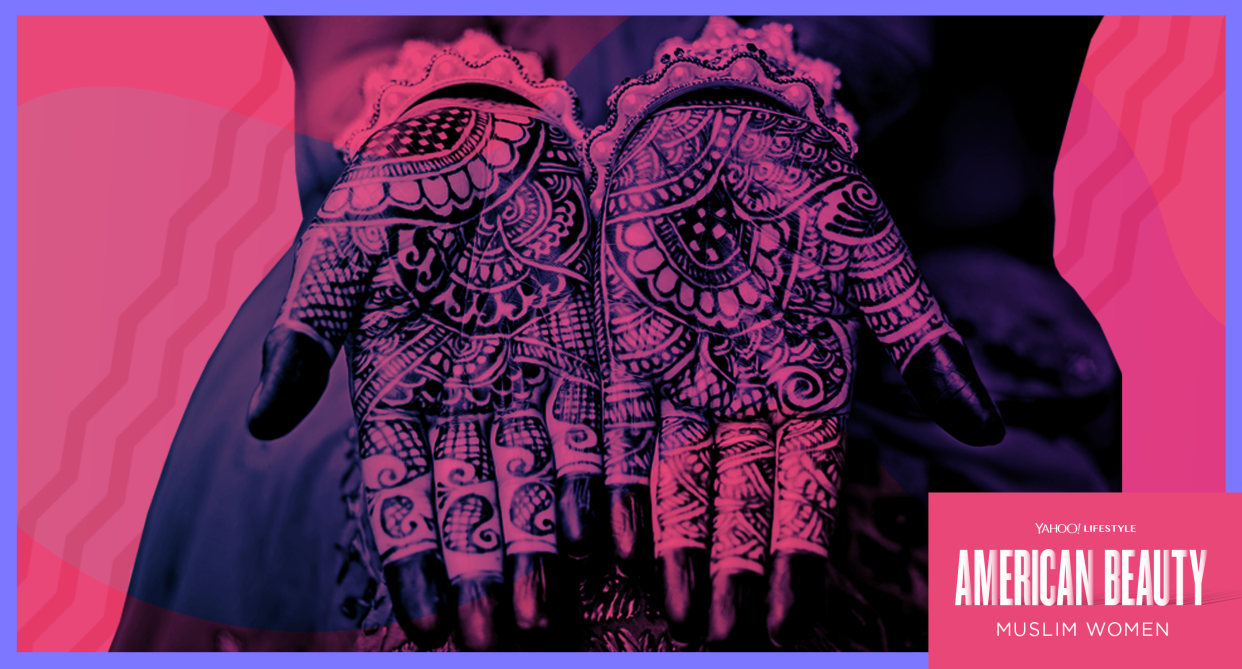Henna tattoos are more than just a beauty trend to 'try on'

“American Beauty” is a new series in which Yahoo Lifestyle takes a virtual cross-country journey to discover what beauty means — reimagining the American flag through the diverse group of faces that make up the United States of America. For our first installment, we’re focusing on Muslim-American women, highlighting what makes this group unique while showcasing the common threads that bring us together. In this feature, Adeline Hocine explains the cultural roots and significance of henna from the perspective of a Muslim woman.
Last summer, I attended Lollapalooza for the first time. The annual music festival, which takes place over a period of four days, is a force of cultural influence. However, many festivalgoers use the event as a free pass to wear appropriative fashion. Turning up in everything from bindis to box braids, white festivalgoers are particularly guilty of reducing cultural practices to temporary accessories for self-adornment — and this includes henna tattoos.
While henna, a small flowering shrub, originated in the ancient civilizations of Egypt and India, the art of using it to create tattoos has also been practiced across Africa, Southeast Asia and the Middle East. Samira Ali, owner of Samira’s Henna Designs, explains that the practice was popularized through trade and travel.
Initially, using henna to create body art (also referred to as mehndi) gave desert communities a way to cool down in extreme heat conditions. Applying henna to the palms and the soles of one’s feet in a circular pattern is a practice evolved over time, leading to the intricate designs seen today.
Henna tattoos are often reserved for special occasions. In many Muslim countries, the practice has been linked with celebrations such as Ramadan and Eid al-Fitr, the holiday officially marking the end of Ramadan.
A post shared by Samira’s Henna Designs (@samiras_henna_designs) on Aug 1, 2018 at 6:39am PDT
For those who grew up in cultures that create body art using henna, the tradition is considered sacred. Muslim women often gather at someone’s home or at a salon, surrounded by good food and loud, joyous music. They are applying henna, but also creating memories rooted in sisterhood and bonding over beauty and self-care.
One of the advantages of using henna to create body art is that it’s temporary. The beautiful designs look like intricate tattoos when they are first applied but fade over time. Henna tattoos first took off in the U.S. around the late ’90s and early 2000s. While their appeal is easy to see, it’s important to acknowledge and respect their cultural significance.
For many women, henna tattoos have a cultural meaning, but as they’ve become more visible among festivalgoers, they’ve given some cause for concern. Kuwaiti artist and activist Farah Salem said, “I moved to the United States two years ago. I see [henna] in festivals all the time and in public spaces. I see people who aren’t from the culture getting designs of symbols that they don’t really seem to understand.”
Samira echoes this sentiment. White women often come to her for henna tattoos, and while she believes in sharing her culture with others, there are times when their requests cause her discomfort. Because designs can be customized, it is not rare for someone to ask that a religious symbol be incorporated, even if they have no affiliation to the religion or understanding of the symbolism. In these cases, she must choose between acting on her personal politics or professionalism. As a full-time artist, she says she opts for the latter.
Tahia Islam is a Bangladeshi Muslim-American and the owner of Reclaimed Womxn Vintage, an online vintage shop creating a space and inclusivity for women of color. When it comes to cultural appropriation, she believes that the best way to avoid it is to give credit where credit is due. “I think it’s really beautiful to share — but acknowledge where you’re getting these cultural aspects from. It’s seen as a costume. It’s never anything more.”
The issue with cultural appropriation is twofold. While the culture itself is rarely credited, those from the culture frequently face prejudice for practicing their own traditions. White women possess the privilege to “try on” other cultures with no consequence. People of color, on the other hand, are discriminated against in educational and professional settings for wearing the emblems of their culture.
A post shared by Samira’s Henna Designs (@samiras_henna_designs) on Sep 28, 2017 at 2:14pm PDT
Muslim-Pakistani writer Rimsha Syed remembers encounters from as far back as the second grade, when fellow students on her school bus noticed her henna body art and called it a “disease.” After 9/11, these encounters and comments increased as the media began to perpetuate a monolithic representation of what it means to be Muslim in America.
“It took me years to realize how the casual racism [I experienced] as an 8-year-old fed into the stigma I held against beautiful traditions and cultural rituals that I very much wanted to embrace,” Syed said. “Years of shame, unlearning, and regaining confidence is why it’s wildly inappropriate to see people get henna tattooed at theme parks and music festivals. My culture is not your aesthetic.”
Particularly in today’s political climate, these rituals can seem key to a community that feels they are necessary for survival. Henna represents more than just the aesthetics of design; it reflects the beauty of a rich and diverse heritage worn proudly on one’s skin, reminding both the wearer and the world of who they are.
Read more about Muslim-American women in our American Beauty package:
9 halal beauty brands that prove the Muslim beauty industry is booming
A look at what life is really like for a Muslim high schooler in NYC
Makeup ‘no longer felt like freedom’: Why I’m a Muslim beauty minimalist


